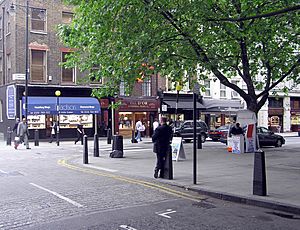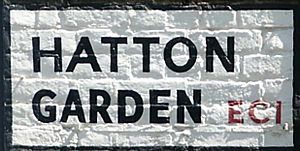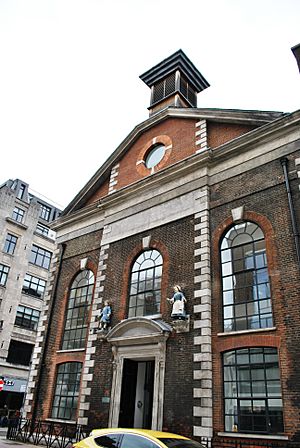Hatton Garden facts for kids
Hatton Garden is a street and commercial zone in the Holborn district of the London Borough of Camden, abutting the narrow precinct of Saffron Hill which then abuts the City of London. It takes its name from Sir Christopher Hatton, a favourite of Queen Elizabeth I, who established a mansion here and gained possession of the garden and orchard of Ely Place, the London seat of the Bishops of Ely. It remained in the Hatton family and was built up as a stylish residential development in the reign of King Charles II. For some decades it often went, outside of the main street, by an alternative name St Alban's Holborn, after the local church built in 1861.
St Etheldreda's Church in Ely Place, all that survives of the old Bishop's Palace, is one of only two remaining buildings in London dating from the reign of Edward I. It is one of the oldest churches in England now in use for Roman Catholic worship, which was re-established there in 1879. The red-brick building now known as Wren House, at the south-east corner of Hatton Garden and St Cross Street, was the Anglican church for the Hatton Garden development. It was taken over by the authorities of a charity school, and the statues of a boy and girl in uniform were then added.
Hatton Garden is London's jewellery quarter and the centre of the diamond trade in the United Kingdom. This specialisation grew up in the early 19th century, spreading out from its more ancient centre in nearby Clerkenwell. Today there are nearly 300 businesses here in the jewellery industry and over 90 shops, representing the largest cluster of jewellery retailers in the UK. The largest of these businesses was De Beers, the international family of companies which dominated the international diamond trade. Their headquarters were in an office and warehouse complex just behind the main Hatton Garden shopping street.
Sir Hiram Maxim had a small factory at 57 Hatton Garden and in 1881, invented and started to produce the Maxim Gun, a prototype machine gun, capable of firing 666 rounds a minute. Hatton Garden has an extensive underground infrastructure of vaults, tunnels, offices and workshops. The area is now home to many media, publishing and creative businesses, including Blinkbox and Grey Advertising. Surrounding streets including Hatton Place and Saffron Hill (the insalubrious setting for Fagin's den in Oliver Twist) were improved during the 20th century and in modern times have been developed with blocks of 'luxury' apartments, including Da Vinci House (occupying the former Punch magazine printworks) and the architecturally distinctive Ziggurat Building.
Hatton Garden development, 1659–1694
The Hatton Garden area between Leather Lane in the west and Saffron Hill in the east, and from Holborn in the south to Hatton Wall in the north, was developed as a new residential district in the Restoration period, between 1659 and 1694. It arose soon after the residential developments in Covent Garden and was contemporary with those of Bloomsbury Square.
It was formerly the site of the medieval palace, gardens and orchard of the Bishops of Ely, forming their City residence. The palace stood in the southeast corner, on the site of Ely Place. During the 1570s Queen Elizabeth's Chancellor and favourite, Sir Christopher Hatton, held a lease of part of the site and developed Hatton House to the northwest of the palace. In 1581, he obtained a more permanent grant from Queen Elizabeth during a vacancy in the see, and after his death, it passed into the possession of Lady Elizabeth Hatton, the widow of Sir Christopher's nephew Sir William Newport (who changed his name to Hatton). At her death in 1646, during the English Civil War, it reverted to Christopher Hatton, 1st Baron Hatton, a close associate of Charles II in his exile in Paris during the Commonwealth period, 1649–1660.
The bishops disputed the Hattons' title, but, under the Protectorate, Bishop Matthew Wren was a prisoner in the Tower of London, and the palace itself was sequestrated to Parliamentarian uses and was badly damaged. To raise money Lord Hatton granted a long lease of the site in 1654, which became effectively permanent in 1658, though he retained the freehold. In 1659, John Evelyn observed Hatton Street (Hatton Garden road) being laid out from south to north, hard against the west side of the palace, as the beginning of a newly planned town district. Speculative builders took leases to construct tall and spacious adjoining houses to attract wealthy men at court, city officials and country gentlefolk wanting London homes, convenient for Clerkenwell and the Inns of Court.
In this way a varied but harmonious townscape, with attractive detail of porches and interior panelling, grew up on a rectangular grid of new streets. Charles Street (at first called Cross Street) was laid west to east as a continuation of Greville Street, and the Bishops' orchard, which (as shown in Richard Newcourt's map of 1658) the Hattons had laid out as a walled knot garden with a central fountain, lay north of that up to Hatton Wall. Hatton Street followed the line of its central path. By 1666, the year of the Great Fire, the development had advanced north to form two principal blocks up to the line of St Cross Street (then called Little Kirby Street). The remaining open land was used as a refuge by Londoners escaping the Fire, which did not consume Hatton Garden.
After Lord Hatton's death in 1670, the northern sector up to Hatton Wall was completed by 1694, in the time of his son Sir Christopher Hatton, 1st Viscount Hatton, whose agent was the noted accountant Stephen Monteage (1623–1687). Work on the Hatton Street church (now Wren House) commenced in 1685–86. Great Kirby Street, parallel to Hatton Street on the east side, enclosed a central block with rear gardens backing, but in the northern sectors, Hatt and Tunn Yard on the east (on the site of Hatton Place) and other small yards on the west provided access to smaller dwellings and coach houses. In the southern sectors King's Head Yard (later Robin Wood Yard, Robin Hood Yard) was similarly enclosed to the west, and to the east Bleeding Heart Yard (Arlidge's Yard, with Union Court) was developed near the palace by Abraham Arlidge (1645–1717), a carpenter of Kenilworth (Warwickshire) origins who worked extensively on the project and made his fortune by judicious investments. Arlidge's survey of 1694 shows the completed estate in detail: he succeeded Sir John Cass as Master of the Worshipful Company of Carpenters in 1712.
Among early residents were Christopher Merret, Robert Ferguson, John Flamsteed, William Whiston and Captain Thomas Coram.
Later the Hatton Garden estate was inherited by George Finch-Hatton esq (great grandson of the 1st Viscount Hatton). He sold it in 1780s and had received around £100,000 and was to receive even more money as it sold further.
Street name etymologies
This is a list of the etymology of street names in the London district of Hatton Garden. Its area has no formally defined boundaries – those used here are the generally accepted ones of Clerkenwell Road to the north, Farringdon Road to the east, Holborn and Charterhouse Street to the south and Gray's Inn road to the west.
- Baldwins Gardens – from Richard Baldwin (or Baldwyn), gardener to Queen Elizabeth I and treasurer of the Middle Temple, who owned property in the area in the 16th century
- Beauchamp Street – from Beauchamp Court, the Warwickshire birthplace of Fulke Greville, 1st Baron Brooke, local property owner
- Black Bull Yard – unknown; this yard has now largely been covered by shop developments and is not accessible to the public
- Bleeding Heart Yard – thought to be from the sign of a former pub in this area called the Bleeding Heart
- Brooke Street, Brooke's Court and Brooke's Market – after Fulke Greville, 1st Baron Brooke, who owned a house near here in the 17th century
- Charterhouse Street – Anglicisation of "Chartreuse", from Grande Chartreuse, head monastery of the Carthusians in France. A nearby abbey was founded by monks of this order in 1371
- Clerkenwell Road – from a local well (the clerk's well), which gave its name to the area to this district.
- Dorrington Street – corruption of ‘Doddington’, from Anne Doddington, wife of Robert Grenville who owned a house near here in the 17th century
- Ely Court and Ely Place – after the Bishops of Ely, Cambridgeshire who owned much of this area prior to 1659
- Farringdon Road – from Sir William or Nicholas de Farnedon/Faringdon, local sheriffs or aldermen in the 13th century
- Gray's Inn Road – from Lord Gray of Wilton, owner of a local inn or townhouse which was later leased to lawyers in the 16th century
- Greville Street – from Fulke Greville, 1st Baron Brooke, who owned a house near here in the 17th century
- Hatton Garden, Hatton Place and Hatton Wall – from Sir Christopher Hatton, who was ceded much of this area from the Bishops of Ely by Elizabeth I in 1577–1580
- Holborn – thought to be from ‘hollow bourne’ i.e. the river Fleet which formerly flowed in a valley near here
- Kirby Street – from Christopher Hatton's Kirby Hall in Northamptonshire
- Leather Lane – thought to come not from ‘leather’ but from Leofrun, a personal name in Old English; formerly known as Le Vrunelane (13th century), Loverone Lane (14th century) and Liver Lane
- Leigh Place – from the Barons Leigh, who bought land in the area from the Baldwin family in 1689
- Lily Place
- Onslow Street
- Portpool Lane – thought to be a corruption of ‘Purta's Pool’, the local area is recorded as the manor of Purtepol in the early 13th century; written "Purple Lane" in Arlidge's Survey
- Saffron Hill and Saffron Street – these used to be the gardens of the Bishops of Ely, where they grew saffron
- St Cross Street – originally Cross Street, as it crossed land belonging to the Hatton family; the ‘St’ was added in 1937 to avoid confusion with numerous streets of the same name
- Verulam Street – from 16th–17th-century lawyer, scientist and philosopher Francis Bacon, later created Baron Verulam, who had chambers at Gray's Inn opposite
- Viaduct Buildings – after their position directly adjacent to Holborn Viaduct
- Waterhouse Square – after Alfred Waterhouse, architect of Holborn Bars, also known as the Prudential Assurance Building, which surrounds the square
Hatton Garden in fiction
Michael Flanders and Donald Swann, humorists in the 1960s and 1970s, celebrated Hatton Garden's connection with the jewellery trade in their song of a sewage worker, "Down Below":
- Hatton Garden is the spot, down below
- Where we likes to go a lot, down below,
- Since a bloke from Leather Lane,
- Dropped a diamond down the drain,
- We'll be going there again, down below.
In Evelyn Waugh's novel Brideshead Revisited, Rex Mottram takes Julia Marchmain to a dealer in Hatton Garden to buy her engagement ring:
Hatton Garden features in the children's novel Smith by Leon Garfield, where the main character tries to elude two pursuers through the crumbling streets of 18th-century Holborn.
In Ian Fleming's novel Diamonds Are Forever, James Bond visits the fictional House of Diamonds in Hatton Garden, where he meets the mysterious Rufus B. Saye.
The name of the street appears in a series of books Poldark by Winston Graham. (part 4 - 'Warleggan')
The Avengers, Series 2, Episode 10, "Death on the Rocks," is set in the diamond business in Hatton Garden.
The diamond robbery in the film A Fish Called Wanda takes place in Hatton Garden.
The 1924 mystery novel Inspector French's Greatest Case by Freeman Wills Crofts takes place in and around Hatton Garden.





